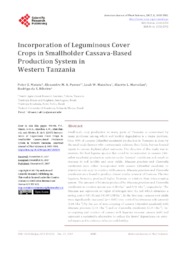Incorporation of leguminous cover crops in smallholder cassava-based production system in Western Tanzania.
Incorporation of leguminous cover crops in smallholder cassava-based production system in Western Tanzania.
Autoria: MATATA, P. Z.; PASSOS, A. M. A.; MASOLWA, L. M.; MARCOLAN, A. L.; RIBEIRO, R. da S.
Resumo: Small-scale crop production in many parts of Tanzania is constrained by many problems among which soil fertility degradation is a major problem. Over 80% of cassava (Manihot esculenta) production in Tanzania is done by the small-scale farmers who continuously cultivate their fields, but use limited inputs to restore depleted plant nutrients. The objective of this study was to examine the best legume species that could be incorporated in cassava (Manihot esculenta) production systems under farmers? conditions and result in increase in soil fertility and crop yields. Mucuna pruriens and Canavalia ensiformis were either incorporated with cassava (Manihot esculenta) or planted as sole crop in rotation with cassava. Mucuna pruriens and Canavalia ensiformis were found to produce almost similar amount of biomass. The two legumes, however, produced higher biomass in rotation than intercropping system. The amount of biomass produced by Mucuna pruriens and Canavalia ensiformis in rotation system was 6.28 t.ha-1 and 5.31 t.ha-1, respectively. The Mucuna use represents an input of nitrogen into the soil which simulates a saving cost of 181.42 and 141.96 US$ ha-1. In the first year, cassava root yields were significantly increased (p < 0.05) over control (continuous sole cassava) (1.44 t.ha-1) by the use of intercropping of cassava (Manihot esculenta) with Mucuna pruriens (2.41 t.ha-1) and or Canavalia ensiformis (2.25 t.ha-1). Intercropping and rotation of cassava with legumes increase cassava yield and represent a sustainable alternative to reduce the farms? dependence on external inputs and to enhance inherent soil fertility.
Ano de publicação: 2017
Tipo de publicação: Artigo de periódico
Unidade: Embrapa Milho e Sorgo
Palavras-chave: Leguminosa, Mandioca, Planta de cobertura
Observações
1 - Por padrão são exibidas publicações dos últimos 20 anos. Para encontrar publicações mais antigas, configure o filtro ano de publicação, colocando o ano a partir do qual você deseja encontrar publicações. O filtro está na coluna da esquerda na busca acima.
2 - Para ler algumas publicações da Embrapa (apenas as que estão em formato ePub), é necessário ter, no celular ou computador, um desses softwares gratuitos. Sistemas Android: Google Play Livros; IOS: iBooks; Windows e Linux: software Calibre.
Acesse outras publicações
Acesse a Base de Dados da Pesquisa Agropecuária (BDPA) para consultar o acervo completo das bibliotecas da Embrapa.

